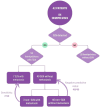Sentinel Lymph Node Detection in Cervical Cancer: Challenges in Resource-Limited Settings with High Prevalence of Large Tumours
- PMID: 40004912
- PMCID: PMC11856111
- DOI: 10.3390/jcm14041381
Sentinel Lymph Node Detection in Cervical Cancer: Challenges in Resource-Limited Settings with High Prevalence of Large Tumours
Abstract
Background/Objectives: Cervical cancer primarily disseminates through the lymphatic system, with the metastatic involvement of pelvic and para-aortic lymph nodes significantly impacting prognosis and treatment decisions. Sentinel lymph node (SLN) mapping is critical in guiding surgical management. However, resource-limited settings often lack advanced detection tools like indocyanine green (ICG). This study evaluated the feasibility and effectiveness of SLN biopsy using alternative techniques in a high-risk population with a high prevalence of large tumours. Methods: This prospective, observational study included 42 patients with FIGO 2018 stage IA1-IIA1 cervical cancer treated between November 2019 and April 2024. SLN mapping was performed using methylene blue alone or combined with a technetium-99m radiotracer. Detection rates, sensitivity, and false-negative rates were analysed. Additional endpoints included tracer technique comparisons, SLN localization patterns, and factors influencing detection success. Results: SLNs were identified in 78.6% of cases, with bilateral detection in 57.1%. The combined technique yielded higher detection rates (93.3% overall, 80% bilateral) compared to methylene blue alone (70.4% overall, 40.7% bilateral, p < 0.05). The sensitivity and negative predictive values were 70% and 93.87%, respectively. Larger tumours (>4 cm), deep stromal invasion, and prior conization negatively impacted detection rates. False-negative SLNs were associated with larger tumours and positive lymphovascular space invasion. Conclusions: SLN biopsy is feasible in resource-limited settings, with improved detection rates using combined tracer techniques. However, sensitivity remains suboptimal due to a steep learning curve and challenges in high-risk patients. Until a high detection accuracy is achieved, SLN mapping should complement, rather than replace, pelvic lymphadenectomy in high-risk cases.
Keywords: cervical cancer; lymphatic metastases; parametrial lymph nodes; radiotracer; resource-limited settings; sentinel lymph node mapping.
Conflict of interest statement
The authors declare no conflicts of interest.
Figures
Similar articles
-
Sentinel node biopsy for diagnosis of lymph node involvement in endometrial cancer.Cochrane Database Syst Rev. 2021 Jun 9;6(6):CD013021. doi: 10.1002/14651858.CD013021.pub2. Cochrane Database Syst Rev. 2021. PMID: 34106467 Free PMC article.
-
Combining Indocyanine Green and Tc99-nanocolloid does not increase the detection rate of sentinel lymph nodes in early stage cervical cancer compared to Indocyanine Green alone.Gynecol Oncol. 2020 Feb;156(2):335-340. doi: 10.1016/j.ygyno.2019.11.026. Epub 2019 Nov 26. Gynecol Oncol. 2020. PMID: 31780237
-
Sensitivity and negative predictive value for sentinel lymph node biopsy in women with early-stage cervical cancer.Gynecol Oncol. 2017 Apr;145(1):96-101. doi: 10.1016/j.ygyno.2017.02.005. Epub 2017 Feb 8. Gynecol Oncol. 2017. PMID: 28188015 Free PMC article.
-
A Prospective Study of Sentinel Lymph Node Mapping for Endometrial Cancer: Is It Effective in High-Risk Subtypes?Oncologist. 2019 Dec;24(12):e1381-e1387. doi: 10.1634/theoncologist.2019-0113. Epub 2019 Jul 3. Oncologist. 2019. PMID: 31270269 Free PMC article.
-
Indocyanine green versus technetium-99m with blue dye for sentinel lymph node detection in early-stage cervical cancer: A systematic review and meta-analysis.Cancer Rep (Hoboken). 2022 Jan;5(1):e1401. doi: 10.1002/cnr2.1401. Epub 2021 May 11. Cancer Rep (Hoboken). 2022. PMID: 33973745 Free PMC article.
References
-
- Olthof E.P., van der Aa M.A., Adam J.A., Stalpers L.J.A., Wenzel H.H.B., van der Velden J., Mom C.H. The role of lymph nodes in cervical cancer: Incidence and identification of lymph node metastases—A literature review. Int. J. Clin. Oncol. 2021;26:1600–1610. doi: 10.1007/s10147-021-01980-2. - DOI - PubMed
-
- Guo Q., Zhu J., Wu Y., Wen H., Xia L., Ju X., Ke G., Wu X. Validation of the prognostic value of various lymph node staging systems for cervical squamous cell carcinoma following radical surgery: A single-center analysis of 3732 patients. Ann. Transl. Med. 2020;8:485. doi: 10.21037/atm.2020.03.27. - DOI - PMC - PubMed
-
- Cibula D., Raspollini M.R., Planchamp F., Centeno C., Chargari C., Felix A., Fischerová D., Jahnn-Kuch D., Joly F., Kohler C., et al. ESGO/ESTRO/ESP Guidelines for the management of patients with cervical cancer—Update 2023*. Int. J. Gynecol. Cancer. 2023;33:649–666. doi: 10.1136/ijgc-2023-004429. - DOI - PMC - PubMed
LinkOut - more resources
Full Text Sources
Miscellaneous



